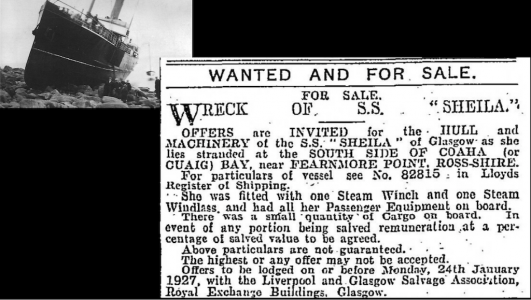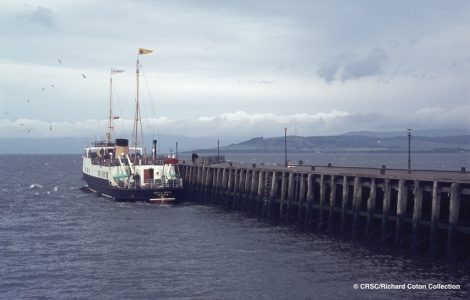
Caledonia at Craigendoran in July 1968: John Newth’s presentation pointed up differences and idiosyncrasies compared to Waverley
CRSC’s meeting at the Maldron Hotel on Wednesday 14 February offered a tantalising mix of topics. The four speakers were each given the task of selecting a ship worthy of recall. Which ones would they choose? Well, this eagerly anticipated meeting did not disappoint. Stuart Craig gives his impressions of what was a superb parade of pictures and stories, and paid-up CRSC members can view all 120 images shown during the evening, in a separate post published here.
It was appropriate, writes Stuart Craig, that on St Valentine’s Day we were entertained by four enthusiasts speaking about a ship that they loved.
First off was Colin Tucker, who convinced us that the little known Stornoway mailboat Sheila was indeed a fascinating and much-loved little ship. Colin was a purser on her better-known successor, the Loch Seaforth of 1947, and so when it comes to ships which have crossed the Minch over the years, he knows what he is talking about.
Sheila, launched in 1904 at A & J Inglis of Pointhouse, was in service just six weeks later, making a daily return voyage from Stornoway to Kyle and Mallaig. She lasted little more than 20 years, as she was wrecked on rocks at Cuaig, near the entrance to Loch Torridon, on New Year’s Day 1927 — fortunately with only eight passengers aboard. During his 20-minute presentation Colin demonstrated his fondness for this little ship – she was not much bigger than the Maid of Argyll – and soon his audience was smitten too.
Of particular interest was a drawing he screened showing the difference in size between Sheila and the mighty Caledonian Isles. Colin’s research on Minch shipping is meticulous, and he peppered his talk with contemporary anecdotes from local newspapers.
The many fascinating accounts from passengers gave us a tangible insight in what it must have been like crossing the Minch 100 years ago. Colin recounted how, at the launch of the 1947 Loch Seaforth at Dumbarton, a MacBrayne dignitary paid tribute to Sheila in the following terms: “Notwithstanding her small size, she was a wonderful ship and did wonderful work.” So MacBraynes must have loved her too.
Next up was John Newth, another well-kent figure at CRSC meetings. The love of John’s life – apart from his dear wife – was the Caledonia of 1934. Built by Denny of Dumbarton, the ‘Caley’ gave sterling service around just about every Clyde pier until her withdrawal in 1969. Instead of a tour of the piers, however, John took us on a fascinating journey round the decks of the ship, pointing out subtle differences and idiosyncrasies compared to that other better known paddler. This is a theme which is often left out of presentations, so to see the insides of the steamer was intriguing.
John’s eye for detail was as acute as ever: “Here is Caledonia on the front cover of the winter timetable for 1967-68, even though she never sailed that winter!” Did you know that her lower deck alleyways were wider than Waverley’s and that her paddle-shaft sat much lower across the floor? John traced her route around the Firth, including her 1969 CRSC charter to Campbeltown and Lochranza, all beautifully photographed. He concluded with the sad story of Caledonia’s destruction by fire in 1980 while based in London as a floating pub/restaurant. However his parting shot, lovingly captured, was a stunningly beautiful photograph of the paddler sailing off into a heavy sea, one which left his audience with equally weighty hearts.
Robert Cleary, another former purser (why did I never think of being one?), chose a much-loved ship of the 1950s and 60s, Maid of Argyll. There can be no arguing with Robert’s choice: as his smashing photographs demonstrated, she was perhaps the neatest and best-kept of the ‘Maid’ quartet. Robert’s love affair with the ‘Argyll’ started with family holidays in Dunoon, where she was a regular visitor. No surprise, then, that years later he would be purser on the ‘Maid’ operating out of Craigendoran.
Absence makes the heart grow fonder, and Robert’s images of Maid of Argyll and Craigendoran Pier in their heyday will have brought back many happy memories. The ‘Argyll’ was his favourite ship to work on, Robert explained , because of the crew. These were clearly happy Cleary times, and we were given an insight into the little ship’s routine. She sometimes carried 500 passengers, but on one trip up to Arrochar she could only manage two!
In Robert’s words, the ‘Maids’ were pretty and well- proportioned ships, with good deck space. They helped keep the smaller piers open, at least for a while, and gave good inter-resort connections. Maid of Argyll was withdrawn in 1972 — a poignant year, Robert explained, as that year also saw the end of the CSP and both Craigendoran and Arrochar piers.
Last, but not least, on this most fascinating of evenings was Cameron Marshall, who joined the CRSC on its charter of Maid of Argyll in 1966 and was yet another former purser, this time on Waverley and aboard his subject this evening – Queen of Scots.

Queen of Scots at Dunoon in August 1977, while substituting for Waverley after her grounding on the Gantocks. She had previously worked as a ferry for oil construction workers at the McAlpine yard at Ardyne Point
Cameron gave us an extraordinarily candid and detailed insight into the 40 days that this little ship was chartered to cover the paddler’s Clyde sailings in 1977, following the latter’s well documented grounding on the Gantock Rocks. Within eight days of Waverley’s accident, Queen of Scots had been moved from Ardyne to Glasgow, had her green funnel repainted in WSN colours and was loading her first passengers for a cruise to Tighnabruaich.
Built on the Humber as Coronia (and renamed Bournemouth Queen when she moved to the south coast in 1968), the 130 foot-long Queen of Scots was an unlikely replacement for the paddle steamer but, as Cameron eloquently explained and ably illustrated, she became very popular due to her neatness, her easily-accessible deck space and the enthusiasm of the crew, who were determined to make a success of her inter-resort sailings.
Although unable to cruise beyond Garroch Head and being fairly slow (“we were once overtaken by a dredger”), Queen of Scots quickly began to draw the crowds. As Cameron explained, “she pioneered the ‘Largs start’: because we couldn’t sail out of Ayr, passengers were bussed up to Largs, and this became part of her success. The catering options were not great but nobody seemed to mind. At the end of the season,” Cameron continued, “none of the crew could look at another gammon sandwich.”
This was a superb evening of four different, short presentations given by speakers who had thoroughly researched their subject and sought out some stunning images to bring them to life. As a Club we are indeed fortunate to have such talent within our membership. Are there others out there reading this who would like to contribute to an evening such as this?
Four ‘members only’ videos, showing all 120 images featured in these presentations, can be viewed here.
Thanks to Roy Paterson, David Cherry, Robert Newth and John Newth for technical support.

Four presentations to remember — by (left to right) Colin Tucker, John Newth, Robert Cleary and Cameron Marshall
CRSC is an association of friendly enthusiasts united by the quest to ‘meet together, sail together and talk together’, mainly on the west of Scotland — but many members hail from further afield. If you join us, you’ll receive copies of our much-prized west coast shipping Review and annual magazine, as well as access to a huge library of archive photos in the ‘Members Only’ section of this website. We gather for meetings and cruises throughout the year. To join us, click here.
Published on 17 February 2024













